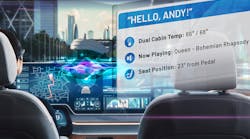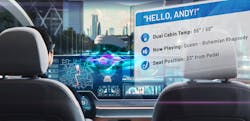What you'll learn:
- The advent of OTA updates.
- Advantages and challenges of software-defined vehicles.
- Why a solid hardware infrastructure is vital to successful software-defined design.
You talk to Siri to get directions and check the weather. In your home, Alexa can turn on lights and your favorite music, as well as heating and air conditioning. We have all become so accustomed to this always-on world that we now fully expect to experience these personalized connections in our automobiles.
Immersive, in-cabin technology has truly transitioned from a nice-to-have to a must-have. In fact, in one study, a vast majority (70%) of millennials consider technology and infotainment as the primary factor when purchasing an automobile.
Welcome to the Age of the Software-Defined Vehicle
The concept of the software-defined vehicle—which roughly defined means a vehicle that manages much of its operation through software—targets this shift in consumer expectations. But while software remains at the forefront of this transformation, hardware will continue to serve as the backbone to enable this software-defined future.
The next 100 years of the automobile will be defined by a more human-centric and experiential approach to vehicle design, one that puts immersive and personalized, in-cabin experiences in the driver’s seat for vehicle purchase considerations. Some figures to support this trend:
- ~ 150M: Average amount of lines of software code in premium vehicles (~50M = latest PC).1
- ~ 18 days/year: Average amount of time Americans spend in their car.2
- ~ 50%: Wished their car had more tech features.3
Beyond this, consumers expect technology to stay modern and upgradable throughout the lifetime of the vehicle. That requires the ability to upgrade software in a similar, seamless fashion as we upgrade mobile electronics and PCs.
The paradigm shift currently underway is centered around a vehicle that adapts to user preferences. How this transition moves forward in the form of in-cabin technology will hinge on manufacturers and original equipment manufacturers (OEMs) embracing these new technologies—and partnering with leading technologists. All of this will incorporate the complicated ecosystem of audio, video, display, voice, etc., to bring about this new expectation for automobiles.
Andy McLean, ADI VP of Automotive Cabin Experience, discusses how a truly immersive, in-cabin experience, powered by software, is the future of automotive.
Above all, safety must be paramount when discussing any vehicle software feature, especially voice-recognition technology, where we must approach near 100% accuracy. Also, safety-critical applications must be processed at the edge, not the cloud, while non-safety-critical applications (music) could be processed in the cloud.
OTA Updates: Safe, Immersive, Personalized
Much like the old days of home computers, where you would add memory chips, motherboards, or even batteries to an aging laptop to run parallel with software advances, software-defined vehicles will need to have a solid hardware foundation that’s flexible enough to be upgradable.
Today’s vehicles are already leveraging software advances for safety (advanced driver-assistance systems, or ADAS) and simplicity (voice-controlled navigation). In addition, software upgrades of these technologies have expanded to vehicle infotainment and diagnostics—all without needing to visit a dealership—thanks to over-the-air (OTA) updates, similar to your phone.
Advantages of Software-Defined Vehicles
- Timely/convenient: No in-person dealer recall is necessary. Simply enable OTA updates in your vehicle and wait for updates to occur, usually overnight.
- Save labor costs: The dealer saves in labor costs due to resources not tied up with recalls that can be fixed OTA (of course, mechanical updates will still need to be done on location).
- Future-proof: Updated vehicles are better equipped as they age, resulting in a slower rate of depreciation, possibly increasing car value.
- Safer/compliant: Vehicles can quickly address compliance/safety rules and standards changes to always stay updated.
Challenges with Software-Defined Vehicles
- Maintenance: Fewer visits to dealer/mechanic mean fewer inspections and fewer opportunities to recommend routine or necessary maintenance.
- Security: A high level of security is needed for OTA updates to protect your personal information and defend against any cyber security threats.
- Hardware requirements: Manufacturers will need to decide to build only top-of-the line vehicles (hardware) to enable software enhancements. All premium hardware vehicles are sold as basic, with upgradability for premium features.
You Don’t Control the Car, the Car Adapts to You
There’s an old saying—a well-fitting suit—used to describe two or more things that work seamlessly together as if they were meant for each other. The same could be said about software and personalization in automobiles today.
We’ve all experienced the initial moments when we get into a rental car, having to adjust seats, mirrors, heating, or air-conditioning, and of course, setting the presets on the radio or touchscreen. With future technological advances, including AI, voice, and facial recognition, this exercise to manually adjust the car to your personal preferences will seem so archaic.
Ideally, shouldn’t the car adapt to you?
Imagine, the car senses you approaching. Through facial recognition, it will know you. As you enter the cabin, it welcomes you (“Hello, Andy!”). Your radio presets and atmospheric conditions are set. Perhaps even, upon ignition, your preconfigured startup sounds like the Starship Enterprise. Overall, the vehicle adjusts and morphs around you and your personalized desires—all configured and deployed automatically, seamlessly.
While the possibilities are intriguing, none of these features will be possible without a robust hardware infrastructure that can help scale the software platform. The conundrum facing many OEMs and manufacturers is: What happens when the software capability surpasses the hardware support level? Much like today’s personal computers, which can live on with minor hardware updates, so too must the software-defined vehicle.
Balancing a Golden Opportunity
The industry has a golden opportunity to capitalize on new business models and revenue streams resulting in post-vehicle sales, including location-based advertising, add-on software-enabled features, etc. But they also will need to balance the desire for continuous software upgrades in the vehicle with the costly overdesigning of hardware needed to support these upgrades.
As the amount of data and compute requirements rise exponentially, the demand will grow louder for a new era in vehicle construction by standardizing, simplifying, and streamlining vehicle architectures—further reducing wire complexity and weight. This will lead to scalable platforms deployed across a complete vehicle fleet.
All of these generational changes drive a need for new system-level and semiconductor solutions, bringing intelligence to the edge and delivering high-bandwidth sensor data to compute units while reducing cable weight and wiring complexity. Although software will provide for easy upgradability of vehicle features, hardware will certainly serve as the backbone that enables scaling of software deployments.
A Hacker’s Dream, a Driver’s Nightmare?
As is the case in anything software-related, cybersecurity must be incorporated into any implementation plan, especially if you’re dealing with the software behind a hardware device hurtling down the road at 80 mph.
With the software ecosystem growing exponentially, a number of defense-hardened strategies could be deployed to protect a vehicle from attack. Foremost, before any OTA updates take place, authentication of the correct driver must be confirmed.
Identity-access management, including facial recognition, could help immensely in this area and is standard practice in the ultra-security-minded financial industry. There’s also isolation-through-virtualization techniques and two-step verification using a cell phone or an email—both proven effective methods to help restrict access.
While OTA updates offer a powerful, convenient feature, and help drivers keep their cars much longer, they also require auto manufacturers to deploy what security tech experts call an assume-harm approach to keep hackers at bay.
Conclusion
Perhaps the ultimate example of a software-defined vehicle may very well be an autonomous-driving vehicle. But until that vehicle arrives, the days of immersive, personalized, truly customizable vehicles are here today. On that front, Analog Devices (ADI) has been heavily involved in engineering the design and implementation of this transformative era:
- Developing software that works together with ADI hardware in a way that enables flexibility to adapt to any operating system deployed by OEMs. Combined with the company’s suite of tools—from selection, through simulation, and eventually production line debugging—it helps ease OEMs’ concerns around a shifting software landscape and accelerates time-to-market.
- Application-focused, algorithm development addresses customer challenges, including active noise cancelling (ANC), road noise cancelling (RNC), and in-car communications (ICC).
References
1,2. "Study: Americans spend 18 days in their car per year, forge close bonds with a vehicle" (thecarconnection.com).
3. "Evaluating Tech Features: Exploring Drivers’ Car Technology Habits and Preferences" | CarMax
4. "Software-Driven Business Models: The Future Of The Automotive Industry" (forbes.com)




